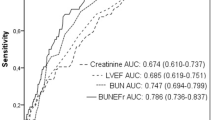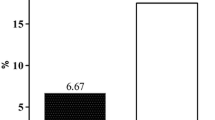Abstract
Contrast-induced nephropathy (CIN) is an important complication of coronary angiography (CAG) and percutaneous coronary intervention (PCI). The aim of this study was to examine the effect of CAG and PCI to renal function in patients with a low risk of CIN by measuring serum cystatin C concentration. The patients were classified into 3 groups; CAG group, elective PCI group, and emergency PCI group. Enrolment continued until 100 patients were included in each of the 3 groups. The exclusion criteria were as follows; (1) serum creatinine concentration >1.5 mg/dL, (2) age >80 years, (3) cardiogenic shock, (4) use of mechanical ventilation or intra-aortic balloon pump, (5) history of renal failure, and (6) quantity of contrast used > maximum radiographic contrast dose. Blood samples for serum cystatin C analysis were collected before and 3 months after the index procedure. Two patients in the CAG group, 4 patients in the elective PCI group, and 12 patients in the emergency PCI group developed CIN. Multivariate analysis identified the predictors of CIN: pre-procedural cystatin C concentration >1.04 mg/L, contrast volume >150 mL and emergency procedure. In the elective PCI group and emergency PCI group, serum cystatin C concentration was significantly increased 3 months after PCI procedure. Even patients with a low risk of CIN developed CIN after CAG and PCI, which caused increase of serum cystatin C concentration. We should become more aware of the possible development of CIN and avoid performing unnecessary CAG and PCI procedure as far as possible.





Similar content being viewed by others
References
Tepel M, Aspelin P, Lameire N. Contrast-induced nephropathy: a clinical and evidence-based approach. Circulation. 2006;113:1799–806.
McCullough PA. Contrast-induced acute kidney injury. J Am Coll Cardiol. 2008;51:1419–28.
Mehran R, Aymong ED, Nikolsky E, Lasic Z, Iakovou I, Fahy M, et al. A simple risk score for prediction of contrast-induced nephropathy after percutaneous coronary intervention. J Am Coll Cardiol. 2004;44:1393–9.
Rihal CS, Textor SC, Grill DE, Berger PB, Ting HH, Best PJ, et al. Incidence and prognostic importance of acute renal failure after percutaneous coronary intervention. Circulation. 2002;105:2259–64.
Nikolsky E, Mehran R, Turcot D, Aymong ED, Mintz GS, Lasic Z, et al. Impact of chronic kidney disease on prognosis of patients with diabetes mellitus treated with percutaneous coronary intervention. Am J Cardiol. 2004;94:300–5.
Kawamura Y, Morino Y, Nagaoka M, Matsukage T, Masuda N, Ikari Y. Impact of chronic kidney disease on clinical and angiographic results following implantation of sirolimus-eluting coronary stents. Cardiovasc Interv Ther. 2011;26:18–25.
Go AS, Chertow GM, Fan D, McCulloch CE, Hsu CY. Chronic kidney disease and the risks of death, cardiovascular events, and hospitalization. N Eng J Med. 2004;351:1296–305.
Perrone RD, Madias NE, Levey AS. Serum creatinine as an index of renal function: new insights into old concepts. Clin Chem. 1992;38:1933–53.
Abrahamson M, Olafsson I, Palsdottir A, Ulvsbäck M, Lundwall A, Jensson O, et al. Structure and expression of the human cystatin C gene. Biochem J. 1990;268(2):287–94.
Laterza OF, Price CP, Scott MG, Laterza OF, Prince CP, Scott MG, Cystatin MG. An improver estimator of glomerular filtration rate? Clin Chem. 2002;48:2297–8.
Newman DJ, Thakkar H, Edwards RG, Wilkie M, White T, Grubb AO, et al. Serum cystatin C measured by automated immunoassay: more sensitive marker of changes in GFR than serum creatinine. Kidney Int. 1995;47:312–8.
Dharnidharka VR, Kwon C, Stevens G. Serum cystatin C is superior to serum creatinine as a marker of kidney function: a meta-analysis. Am J Kidney Dis. 2002;40:221–6.
Nozue T, Michishita I, Mizuguchi I. Predictive value of serum cystatin C, β2-microglobulin, and urinary liver-type fatty acid-binding protein on the development of contrast-induced nephropathy. Cardiovasc Interv Ther. 2010;25:85–90.
Freeman RV, O’Donnell M, Share D, Meengs WL, Kline-Rogers E, Clark VL, et al. Nephropathy requiring dialysis after percutaneous coronary intervention and the critical role of an adjusted contrast dose. Am J Cardiol. 2002;90:1068–73.
Tanaka M, Matsuo K, Enomoto M, Mizuno K. A sol particle homogeneous immunoassay for measuring serum cystatin C. Clin Biochem. 2004;37:27–35.
Ix JH, Shlipak MG, Chertow GM, Whooley MA. Association of cystatin C with mortality, cardiovascular events, and incident heart failure among persons with coronary heart disease: data from the Heart and Soul Study. Circulation. 2007;115:173–9.
Weintraub WS, Spertus JA, Kolm P, Maron DJ, Zhang Z, Jurkovitz C, et al. Effect of PCI on quality of life in patients with stable coronary disease. N Engl J Med. 2008;359:677–87.
Mueller C, Buerkle G, Buettner HJ, Petersen J, Perruchoud AP, Eriksson U, et al. Prevention of contrast media-associated nephropathy: randomized comparison of 2 hydration regimens in 1620 patients undergoing coronary angioplasty. Arch Intern Med. 2002;162:329–36.
Solomon R, Deray G. How to prevent contrast-induced nephropathy and manage risk patients: practical recommendations. Kidney Int Suppl. 2006;100:S51–3.
Author information
Authors and Affiliations
Corresponding author
Rights and permissions
About this article
Cite this article
Tanaga, K., Tarao, K., Nakamura, Y. et al. Percutaneous coronary intervention causes increase of serum cystatin C concentration even in the patients with a low risk of contrast-induced nephropathy. Cardiovasc Interv and Ther 27, 168–173 (2012). https://doi.org/10.1007/s12928-012-0106-3
Received:
Accepted:
Published:
Issue Date:
DOI: https://doi.org/10.1007/s12928-012-0106-3




